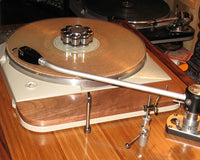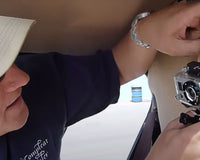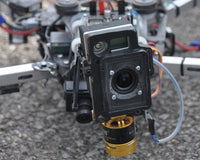Hey everyone, Ian here. In my workshop, one of the most satisfying projects is transforming a car. I’m not just talking about adding horsepower; I’m talking about refining the driving experience. A huge part of that is sound and vibration control. Nothing makes a car feel more solid and luxurious than a quiet cabin, free from rattles, road noise, and resonance.
If you’ve ever gone down the rabbit hole of automotive sound deadening, you’ve undoubtedly come across a huge range of products. The most famous name is Dynamat®, but there are also mass-loaded vinyls (MLV), closed-cell foams (CCF), and of course, our specialty here at Isolate IT: Sorbothane®.
A common question we get is, "Is Sorbothane better than Dynamat?" The answer isn't a simple yes or no. The truth is, they are different tools designed for different jobs. Using the right one—or even using them together—is the key to success.
Let's break it down.
Understanding the Enemy: The Two Types of Automotive Noise
To win the war on noise, you first have to know your enemy. In a car, noise comes in two main forms:
-
Structure-Borne Noise (Vibration): This is noise that travels through the car's metal structure. It's the rattle from your door panels when the bass hits, the drone from the floor pan at highway speeds, and the buzz from the dashboard. This is low-frequency energy that makes the car's panels act like the skin of a drum.
-
Airborne Noise: This is noise that travels through the air into the cabin. It's the whoosh of the wind, the hum of tires on the pavement, and the rumble of the exhaust.
A good sound-deadening project attacks both. This is why a multi-material approach is almost always the best.
Meet the Sound-Deadening Contenders
1. Constrained Layer Dampers (CLDs) - The Panel Tamers
This is the category where Dynamat, SoundSkins, Noico, and similar products live. A CLD is typically a thin sheet of butyl rubber with a layer of aluminum foil on top.
-
How it works: A CLD doesn't block sound. Its purpose is to tame structure-borne vibration. It works by bonding to a metal panel and adding mass (from the butyl) and stiffness (from the aluminum constraining layer). This lowers the panel's resonant frequency and stops it from vibrating like a gong. You don't even need 100% coverage; 25-50% coverage on the center of a panel is often enough to deaden it effectively.
-
Best for: Large, resonant metal panels like the outer door skins, floor pan, roof, and trunk floor. It's your first line of defense against rattles and panel drone.

2. Mass Loaded Vinyl (MLV) - The Sound Blocker
MLV is a heavy, dense, flexible sheet of vinyl. It’s the heavyweight champion of sound blocking.
-
How it works: Pure mass. MLV is designed to be a barrier that stops airborne sound waves from passing through.
-
Best for: Blocking airborne noise like road, tire, and exhaust sounds. For best results, it should be used to create a continuous, sealed layer over a CLD-treated floor pan and firewall.
3. Closed-Cell Foam (CCF) - The Decoupler
CCF is a lightweight foam that won't absorb water (which is critical in a car).
-
How it works: It serves two main purposes. First, it's a decoupler. When you sandwich it between a panel and your MLV layer, it isolates the MLV so it can do its job more effectively. Second, it's great for stopping rattles and squeaks between plastic interior trim pieces.
-
Best for: A decoupling layer in a multi-stage system and for treating buzzes in trim panels.
Enter Sorbothane®: The Vibration Absorption Specialist
So where does Sorbothane® fit in? Sorbothane® is not a CLD, an MLV, or a CCF. It’s a viscoelastic polymer, and it works on a completely different principle.
While a CLD damps vibration by stiffening a panel, Sorbothane® absorbs vibration energy by deforming, converting that mechanical energy into a tiny, negligible amount of heat. It effectively catches and kills vibration before it can travel any further.
Think of it this way:
-
Dynamat tells a panel, "Stop shaking so much."
-
Sorbothane tells the vibration itself, "You're not going anywhere."
This makes it a specialist tool for problems that other materials can't solve as effectively.
The Right Tool for the Right Job: Sorbothane® in Your Car
It’s not about replacing Dynamat with Sorbothane®; it’s about using Sorbothane® where its unique properties offer a clear advantage.
Here are the best automotive applications for Sorbothane®:
-
High-End Audio Installations: This is where Sorbothane® is a true superstar. Use Sorbothane® hemispheres or sheets to decouple your speakers and subwoofers from the car's chassis. This prevents the door panel or trunk from becoming a muddy, resonant part of your speaker. The result is dramatically tighter bass, improved midrange clarity, and a much more accurate sound stage.
-
Targeted Vibration Hotspots: Do you have a specific, stubborn buzz or rattle that CLD and CCF can't fix? A small piece of Sorbothane® placed at the contact point between two vibrating parts can absorb the energy and eliminate the noise completely. It's like a surgical strike against vibration.
-
Protecting Sensitive Electronics: Modern cars are packed with electronics. If you're mounting a component that is sensitive to shock or vibration, building an isolation mount with a Sorbothane® liner is the ultimate way to protect it.
-
A Superior Decoupler: While CCF is a good decoupler, Sorbothane® is in another league. For the most demanding applications, using a Sorbothane® sheet as a decoupling layer between panels provides an unmatched level of isolation.
The Final Verdict
Don't think of it as Sorbothane® vs. Dynamat®. Think of it as Sorbothane® and Dynamat®.
For a complete, no-compromise sound deadening project, the ideal approach is a system:
-
Step 1: Deaden Panels: Apply a CLD like Dynamat to the large metal surfaces.
-
Step 2: Block Noise: Cover the CLD with a decoupling layer of CCF and a top layer of MLV.
-
Step 3: Isolate and Absorb: Use Sorbothane® strategically to decouple speakers, subwoofers, and stubborn trim pieces to absorb the vibration energy at its source.
Ready to take your car's refinement to the next level? Start by identifying your biggest noise problem and choose the right tool for the job. If that problem is vibration, especially for your audio system, there is simply no substitute for Sorbothane®.
Have questions about your specific automotive project? Drop them in the comments below—let's build something great together!










